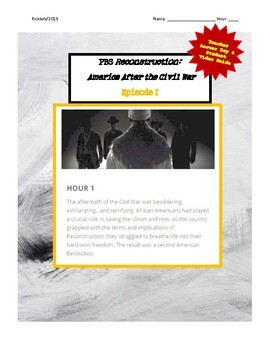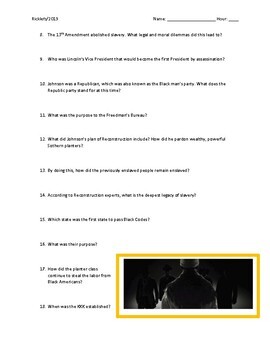PBS Reconstruction America After Civil War ALL 4 HOURS! Differentiated Guide
- Word Document File
What educators are saying
Description
*HOUR FOUR = Help student understand the Capitol attack with history. This covers the coup d'etat in American history as well as the foundation of the KKK and the Charlottesville attack. It is eerily like watching the news in 2021 after the Capitol Attack.*
*Help students understand the foundation of the Black Lives Matter Movement!*
TWO VIDEO GUIDES! Can also be used as homework sheets.
+Simplified for struggling students video guide: Fill-in-the-blank 15 questions with answers.
+Higher level for advanced students video guide: 25 questions with the answers. It is an incredibly detailed video guide
This four part documentary is AMAZING. It intersects interviews of historians with images and captivating stories. This has 25 questions with the answers. It is an incredibly detailed video guide. It can be easily used as homework or a study guide.
HOUR 1
"The aftermath of the Civil War was exhilarating and fraught, hopeful and violent. Four million newly freed African Americans faced the future untethered from the old plantation system, with few rights or protections and surrounded by a war-weary and intensely resistant white population. But for all that, the prayers of generations were being answered: before them was the chance to build new lives and reconnect with family members torn away under slavery.
Black people – soldiers in particular - had played a crucial role in saving the Union. Now, as the country grappled with the terms and implications of Reconstruction, they struggled to breathe life into their hard-won freedom. They could expect little from Abraham Lincoln’s successor, a pro-Union Southerner with little sympathy for the formerly enslaved. Within a few months of war’s end, President Andrew Johnson’s lenient treatment of former Confederates had incited a powerful response among Northerners, especially the Republicans in Congress. The result was tantamount to a second American revolution, in which former slaves and their allies forged new meanings of freedom and citizenship. In the first presidential election after the Civil War, African American men voting for the first time in the South help send Republican war hero, Ulysses S. Grant, to the White House." https://www.pbs.org/weta/reconstruction/episodes/hour-one/
HOUR 2
"Post-Civil War America was a new world. For African Americans, living in the former Confederacy, Reconstruction was, what historian W. E. B. Du Bois once described as their “brief moment in the sun.” Clothed with citizenship and voting rights, now for the first time they could begin to take charge of their own lives, families, and communities – the future seemed limitless. The first black men took seats in the U.S. Congress, in Southern state governments, and on juries; black colleges opened and the Southern states’ first public school systems were organized; newly created black institutions, from churches to mutual aid societies to the Fisk Jubilee Singers, began to flourish; and black families began buying land to farm and opened businesses to achieve a measure of independence from their former masters. But the progress did not last long. White reactionaries in the former Confederacy launched violent attacks to “redeem” their states, to re-establish the old order – a society built on white supremacy.
Over time, Northern support for Reconstruction and military intervention in the South faded, especially with the onset of a tumultuous economic depression in 1873 that led voters to cast ballots for the rival party the following year, leaving Democrats in control of Congress for the first time since the Civil War. By the 1876 Presidential election, both leading candidates – Democrat and Republican – pledged to bring an end to Reconstruction. Following a violent campaign and protracted electoral dispute, the incoming president, Republican Rutherford B. Hayes, made good on his promise to let Southern states control their own affairs. The South had been “redeemed” and the forces of white supremacy were ascendant."
https://www.pbs.org/weta/reconstruction/episodes/hour-two/
HOUR 3
"Hour three of the series examines the years 1877-1896, a transitional period that saw visions of a “New South” set the stage for the rise of Jim Crow and the undermining of Reconstruction’s legal and political legacy. With cotton still king in the South, sharecropping became the dominate economic fate for many black farmers, while convict leasing echoed slavery in new and harrowing ways. During this time, African Americans aptly named the Exodusters, exercised their ability to move freely by leaving the South and migrating west to Kansas with hopes of owning land and living in peace. This exodus would precede the Great Migration in the 1930s; however, it would not remove the stain of segregation. In 1883, the Supreme Court gutted the Civil Rights Act of 1875, thus making it legal for business owners to refuse to serve black patrons. In response to being denied access to public spaces, many African Americans created their own businesses and recreational spaces in a segregated South and in other parts of the county. But even these “safe havens” could not fully protect African Americans from the growing onslaught of violence and lynchings. Fredrick Douglass and Ida B. Wells are among the many key figures who would use the power of their pen to write about the ills of lynching. Others like Isaiah Montgomery and Booker T. Washington would take a more accommodationist approach to tackling injustice. Throughout the episode, African Americans continue to exercise agency over their lives, circumventing attacks and challenges as Jim Crow encroaches and Plessy v Ferguson takes center stage at the Supreme Court, where “separate but equal” would become the law of the land."
https://www.pbs.org/weta/reconstruction/episodes/hour-four/
HOUR 4
"The turn of the century is known as the ‘nadir’ of race relations in America, a period in which white supremacy held sway and racial violence spread across the South. Thirty years after the end of the Civil War, North and South had gone a long way toward reconciling under an American identity that cropped out black people and ignored their claims to the rights of citizenship under the Constitution. Reconstruction became a distant memory, and white supremacist propaganda began to change the story of the Civil War and its aftermath, glorifying the fallen heroes of the Confederacy and painting Reconstruction as a tragic mistake. Popular culture was devastatingly effective in propagating racist tropes in this era; from soap advertisements to minstrel shows, a flood of offensive imagery denied the humanity of African Americans. But even facing both physical and psychological oppression, African Americans found ways to fight back. With photography, theater, music, and writing, they began to put forward their vision of a “New Negro” for a new century."
https://www.pbs.org/weta/reconstruction/episodes/hour-four/
Hour 1:
Topics include:
Slavery
Union Army; Confederate Army
Lincoln's Assassination
Johnson
Black Codes
Jim Crow
KKK
The Civil Rights Act of 1866
Voting Rights
Hour 2:
Public Education
Black Congressmen & Politicians
Farming
President Grant
Lee's Death
Black Tax
Jim Crow/Mistrels
KKK
The Civil Rights Act of 1875
Frederick Douglas
President Hayes
Hour 3:
National Farmers' Alliance
Isaiah Montgomery
Disenfranchisement
Black tax
Voting rights
Lynching
Mobs
Ida B. Wells
Black journalism
The World's Fair
Douglas
Booker T. Washington
Plessy vs Ferguson
Hour 4:
White supremacy
Black Congressmen
The Lost Cause
Jim Crow
Confederate monuments
Photography
Stereotyping
DuBois
New Negro Generation
Bert Williams and George Walker
Minstrels
NAACP
President Wilson
Images from: https://www.pbs.org/weta/reconstruction/home-preview/
PLEASE READ: Each video is approximately one hour long. This means there are a plethora of questions per each video guide and it moves quickly. I include so many video guide questions so that teachers can either use them all OR pick and choose which ones the educator wants students to focus on. It is very detailed. I traditionally have students either 1.) buddy up and share answers they missed 2.) do every other or every third question 3.) some variation of think, pair, share with the questions or 4.) have them complete what they have time for.





